How Much Does it Cost to Make a Social Media App Like Instagram
- Mobile
- June 27, 2023
From sharing daily life updates with social friends to getting morning motivation and entertainment for the boring time, social media platforms have become an essential part of our life.
As of April 2023, social media users have surged to the number of 4.8 billion, around 59.9% of the global population. If we consider previous years’ numbers for the social media users’ increase rate, we can say that around 11-13% of social media are increasing every year.
From this number of social media users, in January 2023, the highest number of social network users – around 2,958 million were surveyed using Facebook, followed by YouTube at 2,514 million users with WhatsApp and Instagram at 2000 million users, and then other platforms.
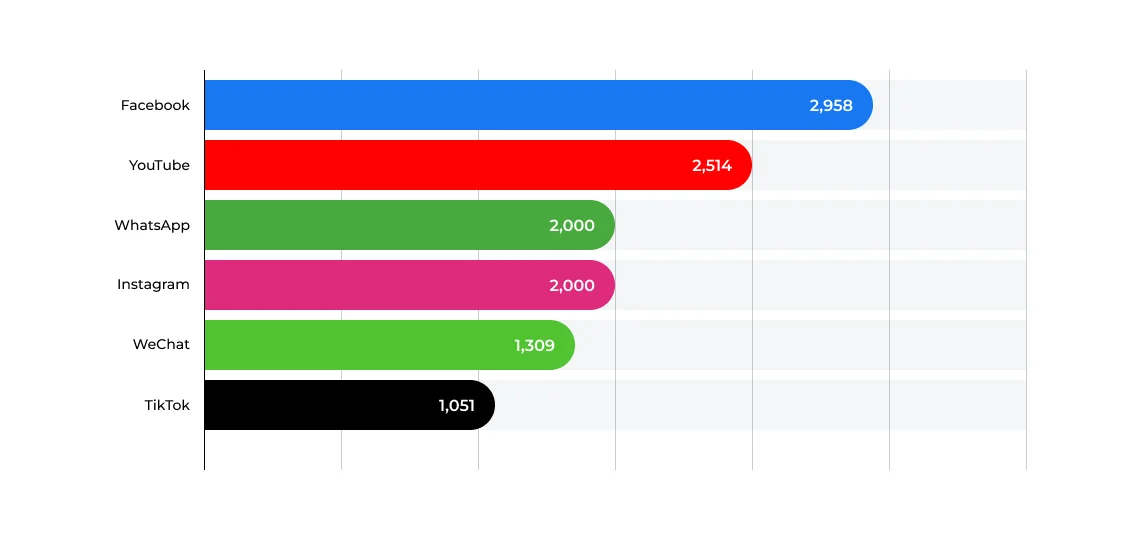
Still, Facebook and Instagram are in peak positions and have become the undisputed rulers of social media and are rightly considered the most robust platforms to connect with the global audience.
From all those, Instagram has a notable place in the hearts and minds of every social media enthusiast due to its unique proposals for each category of users, from casual users to influencers to businesses.
And hence, if you’re planning to build your social media app, then assessing the app architecture and specifications of the Instagram app can be of great help. And that’s the reason, here, we have presented our extensive study on the Instagram app and key takeaways that will help you create your social media app development plan.
So, let’s not wait for the screen to refresh again and begin with the story of Instagram being the hot topic in the social media world.
The Evolution of Instagram
Speaking of the journey of Instagram, there has been a massive progression in this photo and video-sharing social networking platform owned by Facebook Inc. ever since it made its advent on 6th October 2010.
It was quite surprising to note that Instagram has received a tremendous response from the worldwide audience. In fact, within a couple of months of its inception, it counted considerable registered users. But it gained a real hike after social media giant Facebook acquired it in the year 2012.
If we see the statistics of Instagram users from 2013-2021, it has popularized from 90 million to 2000 million users.
The progress of Instagram didn’t stop there – the number of active Instagram users has then increased from 1.04 billion to 1.35 billion for the timeline 2020-2023. And it has been predicted to spike the number of active Instagram users by around 1.44 billion by 2025.
One of the exemplary reasons for its enormous growth is the fact that Instagram, like Facebook, offers the most effective services to not only communicate with friends and relatives on a personal note, but it has become an empowering tool for the promotion of business and marketing helping you to reach out more customers.
Instagram allows its users to upload images and videos. You can also edit them using the filters. In addition, you can also tag a location and share it publicly or with a selected group of followers. The users can also access other accounts, follow them and add content to a feed.
For better understanding, let’s understand the evolution of Instagram according to the timeline.
- In 2010, Instagram was simply launched as a photo-sharing app for iOS;
- In 2011, introduced post like and comment features and post the media with supporting hashtags for content relevancy.;
- In 2012, Instagram was released for Android with video sharing and Insta Stories features;
- In 2013, introduced photo tagging and “Photos of You” – media in which the users are tagged, sponsored post advertising feature for the US region, and enabled users with direct media sharing, like features;
- In 2014, Instagram launched more media editing tools and made its product more advertising friendly;
- In 2016, Instagram introduced multiple accounts in a single app feature for users to easily switch to another account. This year was a breakthrough for Instagram, as it was able to introduce so many new features to the social media enthusiasts, such as post zoom-in, comments, desktop-friendly apps, etc.;
- In 2017, it enabled users to upload carousel media posts, make threaded comments, short video uploads like TikTok, and follow hashtags features;
- In 2018, it introduced the IGTV feature to make this app the biggest competitor of YouTube;
- In 2019, it announced in-app online shop features to easily buy goods from it directly;
- In 2022, introduced vanish mode, allowing users to keep their chats secret that vanishes every time they read it and switch to another tab in instagram;
- In 2023, Instagram announced the Meta Verified feature, a subscription-based verification system, which asks for government ID as proof of account verification to avoid account fraud.
Now that you know the thrilling evolution story of Instagram, you do want to know the reasons behind the success of Instagram to consider that for your mission-critical social media app.

Reasons Behind The Success of Instagram
If you check, you’ll find several reasons behind the success of Instagram, and some of those include:
- First and foremost – Instagram is a visual content-based platform that allows users to post their multimedia content with their network and share their liking of visual content with their close group of people;
- Another is its appealing and easy-to-use social media app interface, so any naive user can use it without deep study and analysis;
- Instagram offers too many exciting features to users, making their social media use easy. To name a few, it offers advanced security and privacy, theme selection for the whole app and chat room, carousel posting, the 60s of reels, multimedia sharing through Stories that remains live for 24 hours, and even allows archived stories to be put in the main user profile highlights section, Vanish mode, Live, business tools, content creators’ tools, etc.;
- It offers effective post boosting and advertising with analytics support for businesses to spread their brand awareness and grow their business;
- Due to its many offerings, it was able to create a strong community of social media enthusiasts with much freedom to share their thoughts and visual content with their network with such regulations to avoid hurting someone else’s ethical and moral values.
In short, the concept of Instagram is itself an award-winning social networking app, but its UI/UX design and top-notch user experience make this platform successful.
Fascinating Social Media App Features You Can Implement into Your App like Instagram
Now that we know the top reasons behind the success of Instagram with its history, let’s have a look at some fascinating Instagram features you can implement into your social media app:
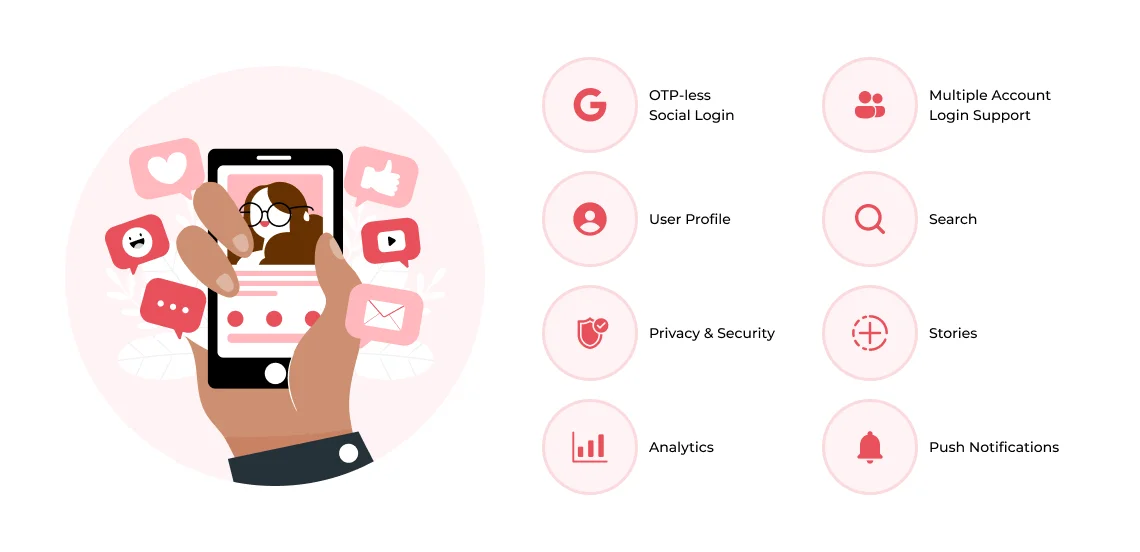
1. OTP-less Social Login
With Instagram bringing the next level of convenience for creating and logging into the Instagram user account with social media signup/login, it’s becoming the trend in the industry.
Alongside user convenience, it also provides users better security by avoiding account login activity – password entering in front of other users.
2. Manage and Share User Profile
In the next step, you should focus on building the option of creating and editing profiles so that users can start sharing their photos and videos. In addition, users also get the option of editing their profile, where they can change their personal details, profile picture, bio, and much more.
With the account creation and username update, you should ensure that your app generates a unique user profile QR code with user ID information and an account link-sharing option that allows you and your followers to share your profile with other users.
If we talk about the backend, you must establish an interaction between the client and the server side app.
You can also enable your users to create their social media highlights using story archives and customized covers for the particular archive. Moreover, you can also allow users to archive profile posts as a better version of the delete option for convenient user profile management.
3. Multiple Account Login Support
Just like Instagram, you can also implement this very useful feature that enables users to keep multiple accounts in a single app with ease to switch to another account. It lets creators and business owners manage their personal and business accounts effortlessly.
Not just that, you can make your social media app so advanced that it can remember the passwords of all accounts and let you easily log out and log in without any further effort of entering login credentials.
Implementing this advanced support may require you to invest in more cloud computing solutions and require a highly experienced team of mobile app developers to implement it and scale it smoothly like spreading butter on bread.
4. Upload Media From Your Phone Storage
Next, you have to start with implementing the photo and video upload feature, which is said to be the most important tool or the base of platforms like Instagram. The users can choose the images from their phone’s storage.
As far as the backend is concerned, you have to opt for a different approach both for the Android and iOS platforms. In the case of Google, the initial activity is reading the Camera API, MediaRecorder classes, android.hardware.camera2 API, and SurfaceView.
On the other hand, if you are developing an app for iOS devices then you have to use UImagePickerController, which is a part of the UIKit Framework.
5. Media Customization and People Tagging
While uploading the media into Instagram, you can also provide users a media customization feature, like applying filters, rotate, crop, expand or compress media, and many more options to edit their photos and videos before uploading them.
Along with that, you can also implement a tagging feature with Photos of You feature to tag users or account handles before publishing for better linking and letting people know who the other people are.
Moreover, just like Instagram has, you can also include “Photos of You” where you can find other posts of others where you’re tagged in.
The implementation of these features will help you provide users with better personalized account management experience.
6. Explore Personalized Suggestions for Trending Media
In social networking and media-sharing platforms like Instagram, what the audience wants to get is to explore new media uploaded by others based on their interests and trends in such interest areas. And Instagram made it possible with its Explore Feed, Reels, and many other media suggestion windows.
You can also implement such a feature by hiring data analysts and scientists, and AI developers to offer your target social media users personalized media suggestions they might want to explore.
7. Insta Story and Other Story Features
Insta story is a great way to share your thoughts, multimedia, and many other things with GIFs, Stickers, Locations, People Tags, Music, and many other elements to make your story appealing to look at.
Read More: How To Build An App Like Threads? – Everything You Need To Know
8. Home Page and Suggestions
The home page is the most personalized window for users to find the content of the users they have followed, and Instagram has implemented it quite considerably.
You can also take inspiration from Instagram for this section which shows users stories and posts of the users they have followed, along with some personalized suggestions for the media and ads they might be interested in checking out.
9. Search and Filters
The search option helps the users in finding their friends, groups, and known acquaintances on social media apps. When the user searches anything in the search, you get advanced filters to explore, such as For You, Account, Audio, Tags, and Places, for better search results.
Apart from that, they also get familiar with the hot topics that are currently trending topics on social media platforms based on keywords, like new song status, sports shorts, traveling reels, and many other suggestions to explore trending content based on users’ interests.
The users choose their preferred option, and the backend server offers the desired results.
10. Subscription-based Verification Option
Recently, after seeing the success of Twitter in the subscription-based account verification purchase option, Instagram has also implemented this feature to enable creators and businesses to rent a verification badge with proof of government ID to avoid identity fraud.
Inspired by this, you can also implement a subscription-based account verification option to make your social media app a Semi SaaS Solution.
11. Analytics
Social media users who are creators and business owners do want to get insight into their post and profile reach, engagement, follow and unfollow rate, and much more, to get ideas on creating their next content. And Instagram understands the potential of this business tool and has enabled users with public, creator, and business profiles to get better content and account insights.
By leveraging big data and data analytics and AI/ML you implement this advanced analytics feature into your social media app like Instagram.
12. Privacy & Security
In social media, what most users need is their account privacy, which in Instagram can be done by simply marketing the account private and setting some additional privacy fields like who can see your profile, stories, posts, and live with account restriction feature, close friends marking, and hiding likes and comments.
For the social media security implementation, you can enable your users with security settings, like two-factor authentication, login alerts, and change password facility, location & device information from where users’ accounts have been logged in.
By implementing such security features, you can ensure better integrity with your social media users.
13. Push Notification
Push notifications play an essential role for any mobile app and desktop applications, and for social media like Instagram, it’s really important to implement push notifications.
When planning to build an app like Instagram, you must include this feature in your business-critical social media app.
You can also provide customization for the push notifications with some privacy enablements, like making users enable notifications to be delivered quietly without revealing the intent behind it, for example, “you have one new notification from Instagram” rather than “XYZ person has shared one post with you.”
14. Ads and Boosts
Just like Instagram allows creators and businesses to create and circulate advertisements about their content and offerings, you can also implement an entire advertising toolkit for your users to promote their social media activities.
You have to link your social media app with ad servers, like AdSense, OpenX, or any other one, to allow your users to create and target social media ads and showcase those to other targeted users.
15. In-app Chat, Call, and Video Call
Well, social media apps are incomplete without being able to share your favorite media content with your friends and family and discuss such through chat, calls, and Facetime. Instagram makes all possible with the addition to customize each chat room with different themes.
When it comes to user privacy, Instagram has implemented a great feature called Vanish Mode that deletes users’ chat the moment they come out of that chat room.
So, inspired by Instagram, you target to implement in-app community features with privacy features like chat disappearance after a few seconds or minutes. For the security of users, you can implement 256-bit end-to-end encryption of their private chats, calls, and video calls to make them communicate freely.
At the same time, it is also very essential to protect the server from excess loading of incoming and outgoing messages. In order to achieve your ends, you can make use of the RESTful API on HTTP as a replacement for permanent socket connections.
Similarly, if you want to have the notifications implemented, then it is better to get linked with the Android or iOS server through device authorization on the server. You can use APN or GCM for doing it.
16. Geo-location
Indeed, the geo-location feature has been regarded as a pivotal tool necessary for almost all social media apps.
This feature facilitates the users by providing their exact location while posting a photo or video in their profile. It makes it easier for others to see their location.
In order to implement this feature into your app, you would need the support of APIs. And here, too, the approach for both Android and iOS becomes distant, for which you need the services of Maps and Locations.
For instance, the Android app developers need to use the class of android.location package and maps service by employing the MapView class.
On the contrary, the iOS app developers will need the help of CLLocationManager Class and maps service using the Map Kit framework.
After the front end receives the data from a sensor, they send it to the backend. However, you need to obtain the permission of the user before sending the data.
The data gets saved on the server side, and the image is returned to the user indicating the location.
Advanced Features You Can Also Include Into Your Social Media App Like Instagram
Well, we’ve seen some great features implemented in the Instagram app. So, now, it’s time to know some advanced features you can implement into your social media app like Instagram:
1. In-app Store
This feature was once in Instagram that enabled stop owners and artists to sell their goods, such as clothes, shoes, skincare & cosmetics, or anything else, conveniently from their profile. Though Instagram discontinued this feature in a shorter period of time.
But you can still implement this feature to make your social media app more than just a networking app that offers many in-app services.
2. CMS – Social Media Content Management System
It’s an app’s total content management system that enables admins with many app management conveniences, such as:
- Admin Authorization: Using this, Admins can register their profile, set a password and log in and out from the CMS;
- Admin Management: This feature enables admins to manage other approved admins and perform CRUD operations of administrators;
- User Management: As the social media-specific CMS solution contains data of each and every user, admins can leverage this to do basic sorting, filtering, and searching of users and divide them into categories to suggest personalized content;
- Manage Reported Users: This is the most important enablement social media admins can get. Leveraging this, they can filter reported accounts based on the number of claims and entities for what they are reported.
Also Read: 10 Crucial Enterprise CMS Features that You Must Integrate
3. Fundraiser Tools
Seeing the global problems happening nowadays, you can also take this opportunity to contribute to global welfare by implementing fundraising tools for NGOs and Relief communities to collect funds and use them to make this world a better place to live.
You can implement fundraising tools in such a way that can enable users to create their crowdfunding campaign, promote their fundraiser, and even launch their fundraiser through social media apps.
Some of the popular fundraising tools used on social media platforms are Facebook Fundraisers, GoFundMe, Patreon, and Giver.
Instagram App Architecture and Technology Stack
Well, in an app, along with features and functionalities, you should also consider the architecture to create a robust app like Instagram.
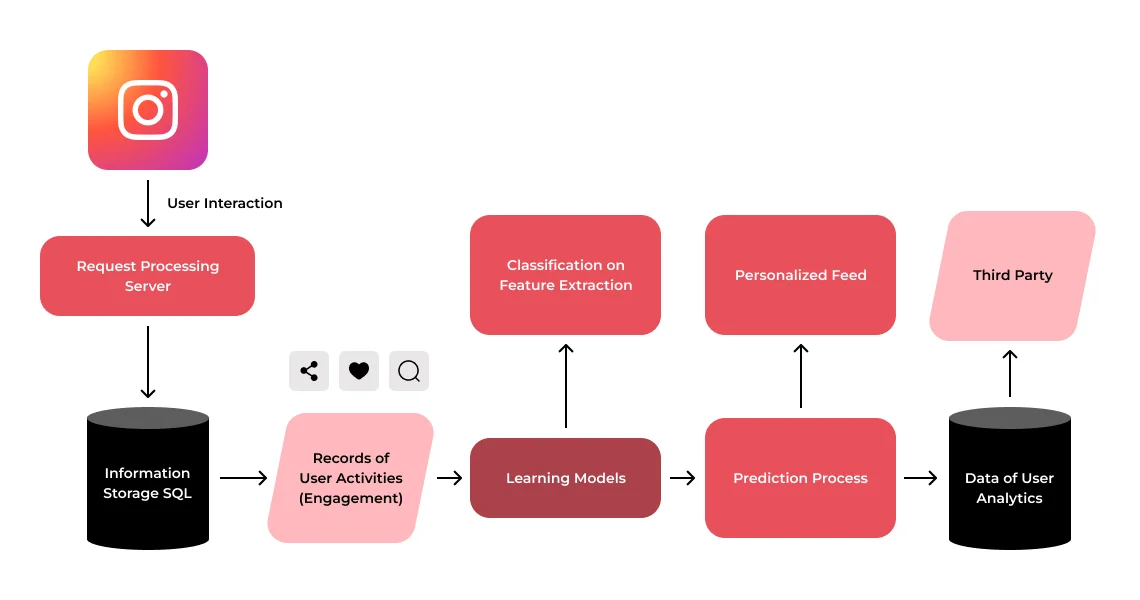
Have a look at the below-presented image of the architecture of Instagram:
- Here, the user, of course, interacts with the frontend of the app, where they send requests to the server to perform certain actions;
- Then the server will fetch and process that information;
- And the outcome will be reverted to the user while ensuring their understandability.
Technology Stack
If we talk about the technology stack, then you can consider the following technology stack for building your app like Instagram:
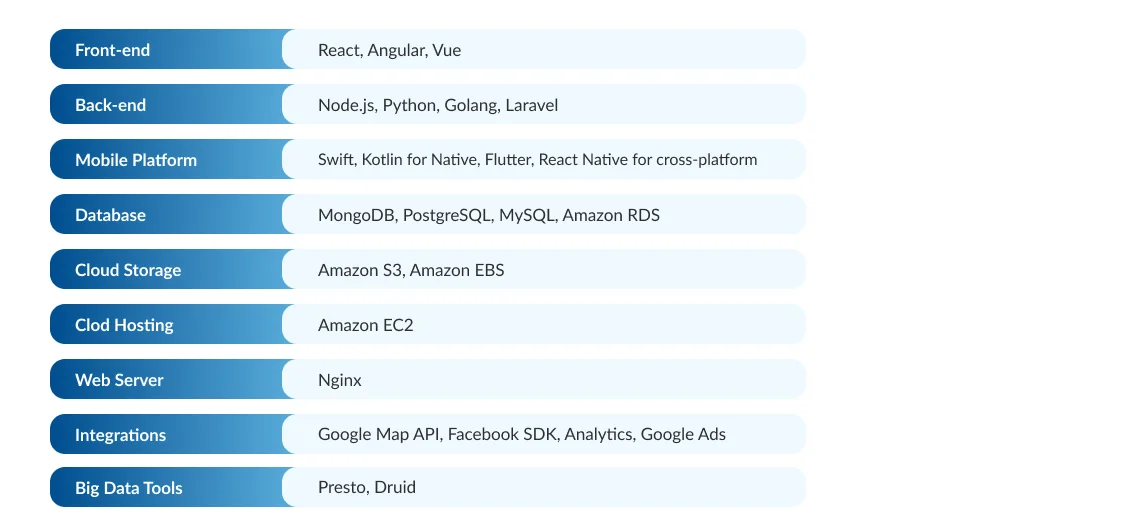
How Much Does it Cost to Build an App Like Instagram?
It is very tricky for anyone to give you the exact cost of developing any mobile application as each of the clients has a different requirement, and the cost varies according to their needs.
Usually, the price is decided based on per-hour development cost, or the app development company offers the total cost of creating your app, which you have to pay at one time or in installments.
Moreover, the cost of developing an app like Instagram also depends on many factors, such as:
- The complexity of the app design and development requirements;
- No. of team members required to hire;
- The country of the talent team;
- The type of engagement model selected;
- Technology stack selected;
- No. of features and functionalities to be implemented in the app.
But it’s highly advisable to hire dedicated social media app UI/UX designers and mobile app developers to build your mission-critical social media app like Instagram.
Here’s the estimated hourly cost for hiring talents for your Instagram-like app development project:
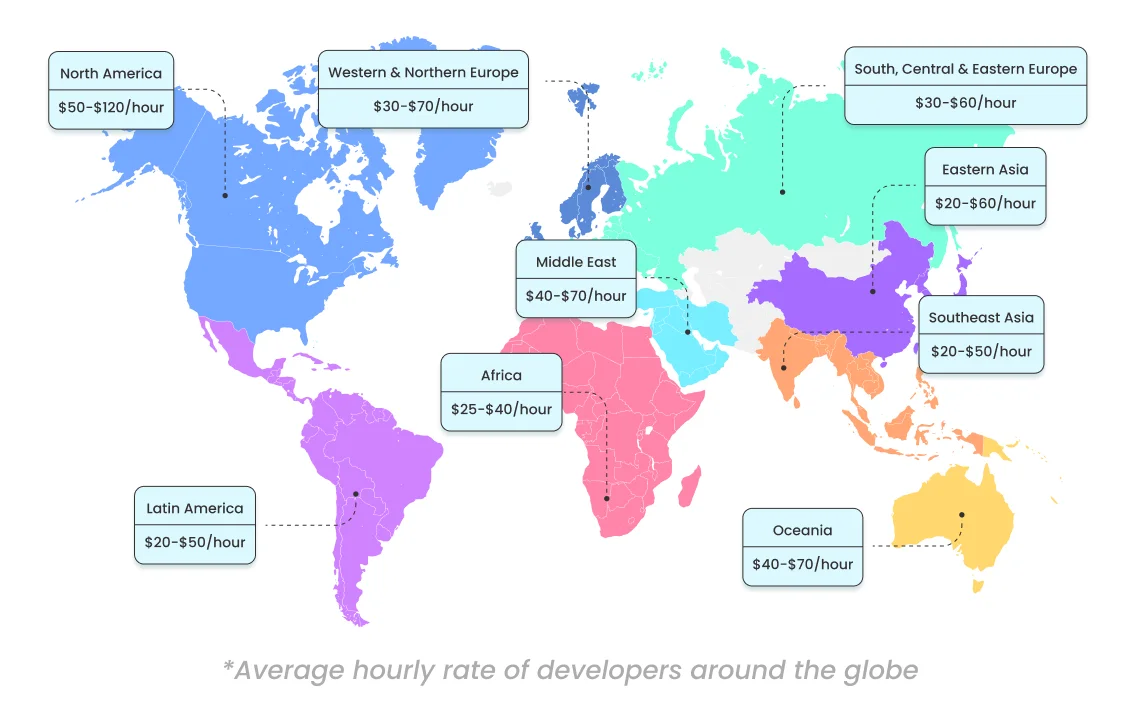
Note: Remember that this cost is subjective to the time and demands, which may change based on global cost-affecting variables.
Wrapping Up
This era belongs to the age of social media apps. Having a social media platform such as Instagram would offer an all-around advantage to instigating your business prospects.
Don’t forget people like to use new social media platforms, and if you provide them with that extra benefit, you can become the leader of the race.
For startups, you can begin with a simple and sophisticated approach, but as time goes on, you can scale your app more.
If you are also looking forward to creating a social media app similar to Instagram, get in touch with us to get a better social media solution for your amazing app idea!
FAQs About Instagram Like App Development Cost
To make a social media app like Instagram, you must follow the steps, like app ideation and market research, finding and consulting a social media app development partner, defining app features and functionalities, finalizing the technology stack, doing app architecture planning, app UI/UX designing and prototyping, MVP development, full-fledged app development, testing and quality assurance, app launch, and providing post-launch support & maintenance. Are you looking for a reliable mobile app development partner? Contact us now!
As you know, the time to develop an app depends on the complexity of the project and the experience of the app developer, along with the experience of the development team and technology stack you’ve selected. However, you can get in touch with us to get further time and cost estimation.
It is worth investing in the development of social media apps like Instagram due to various reasons, like a larger user base, higher engagement, revenue from enabling advertising in the app, helps businesses to spread their brand awareness with backlinks, and create a channel for the creator monetization.
You can earn money from an app like Instagram by creating channels for advertising, selling in-app services (subscription-based services), affiliate marketing, promoting sponsorships, creator monetization, and many others.













